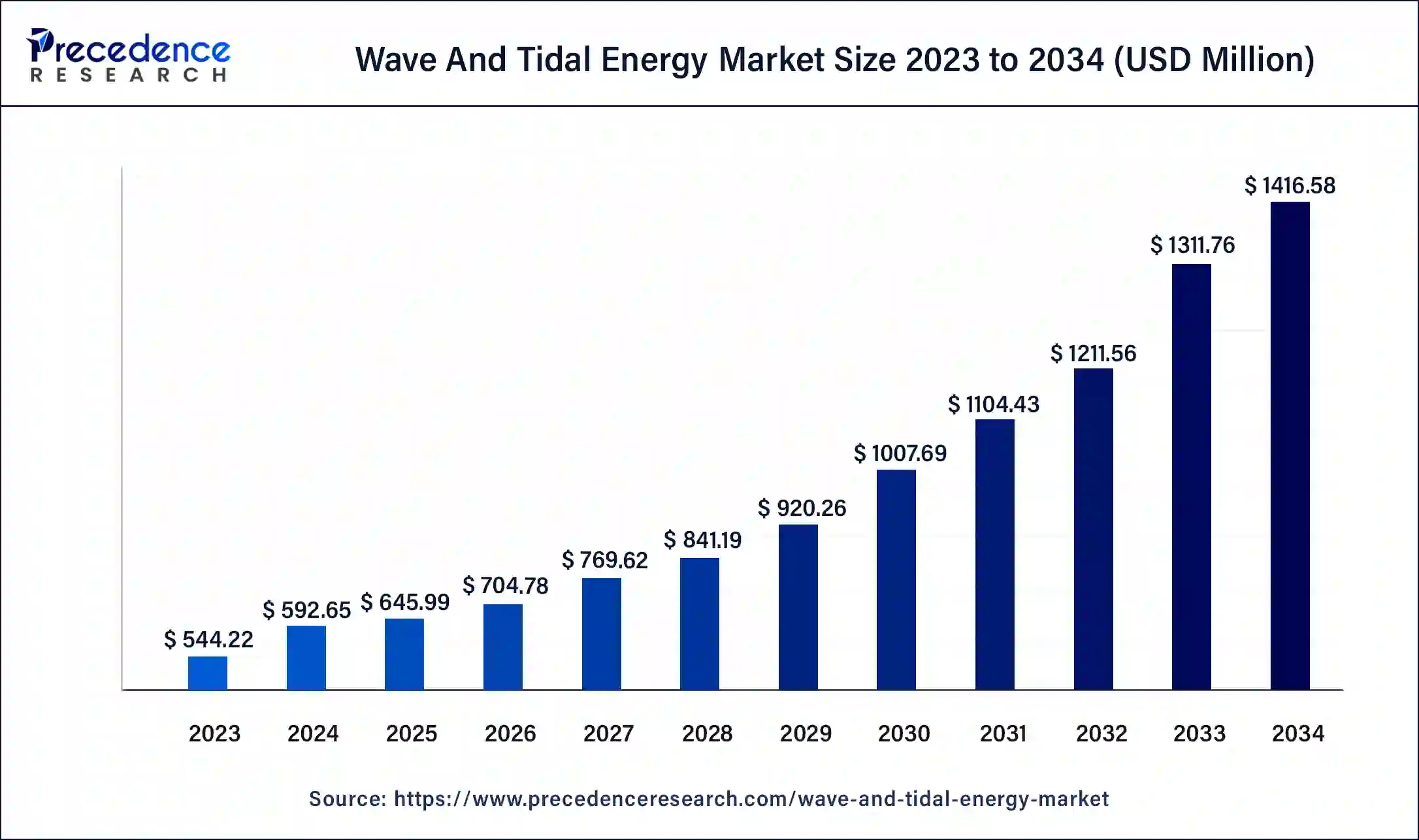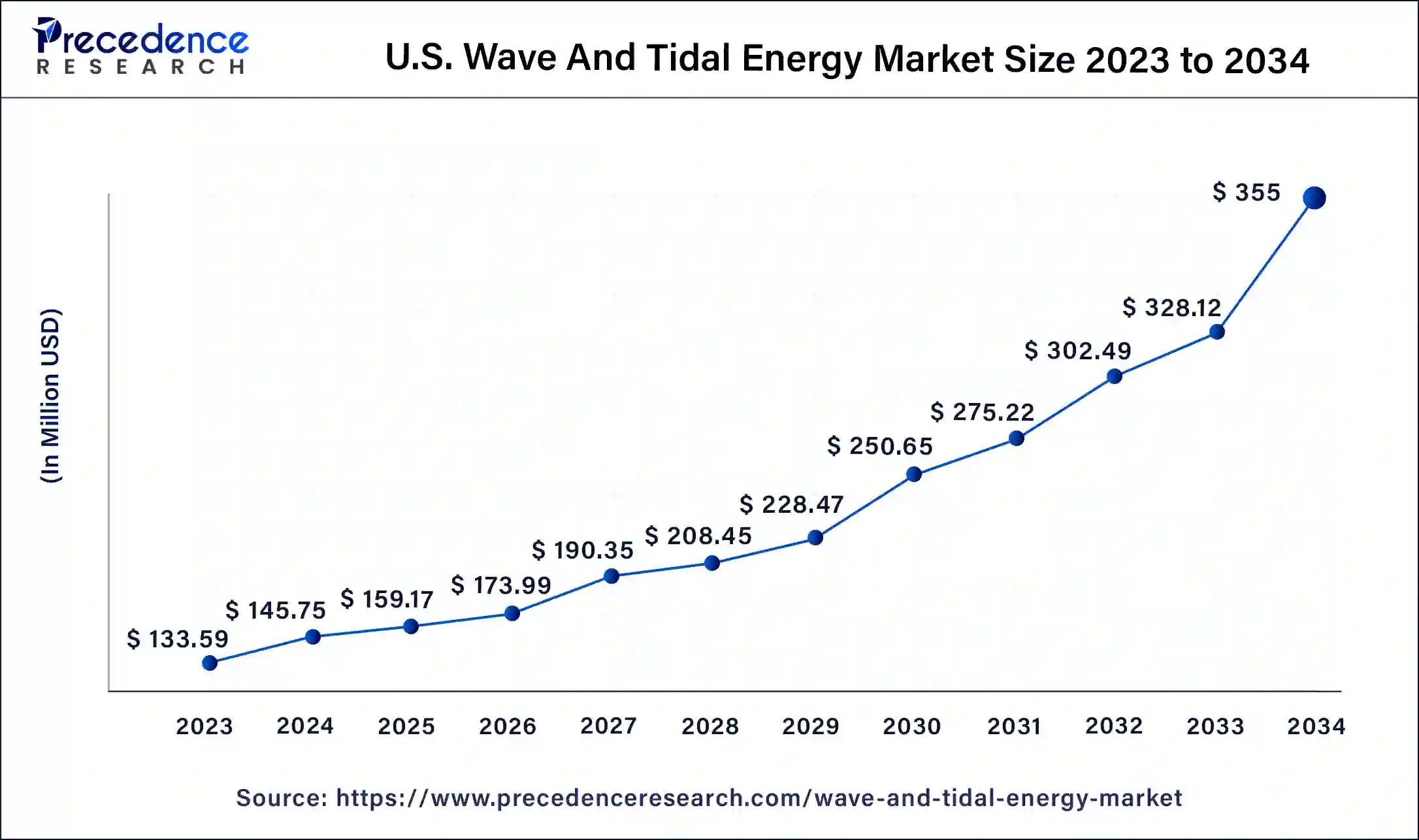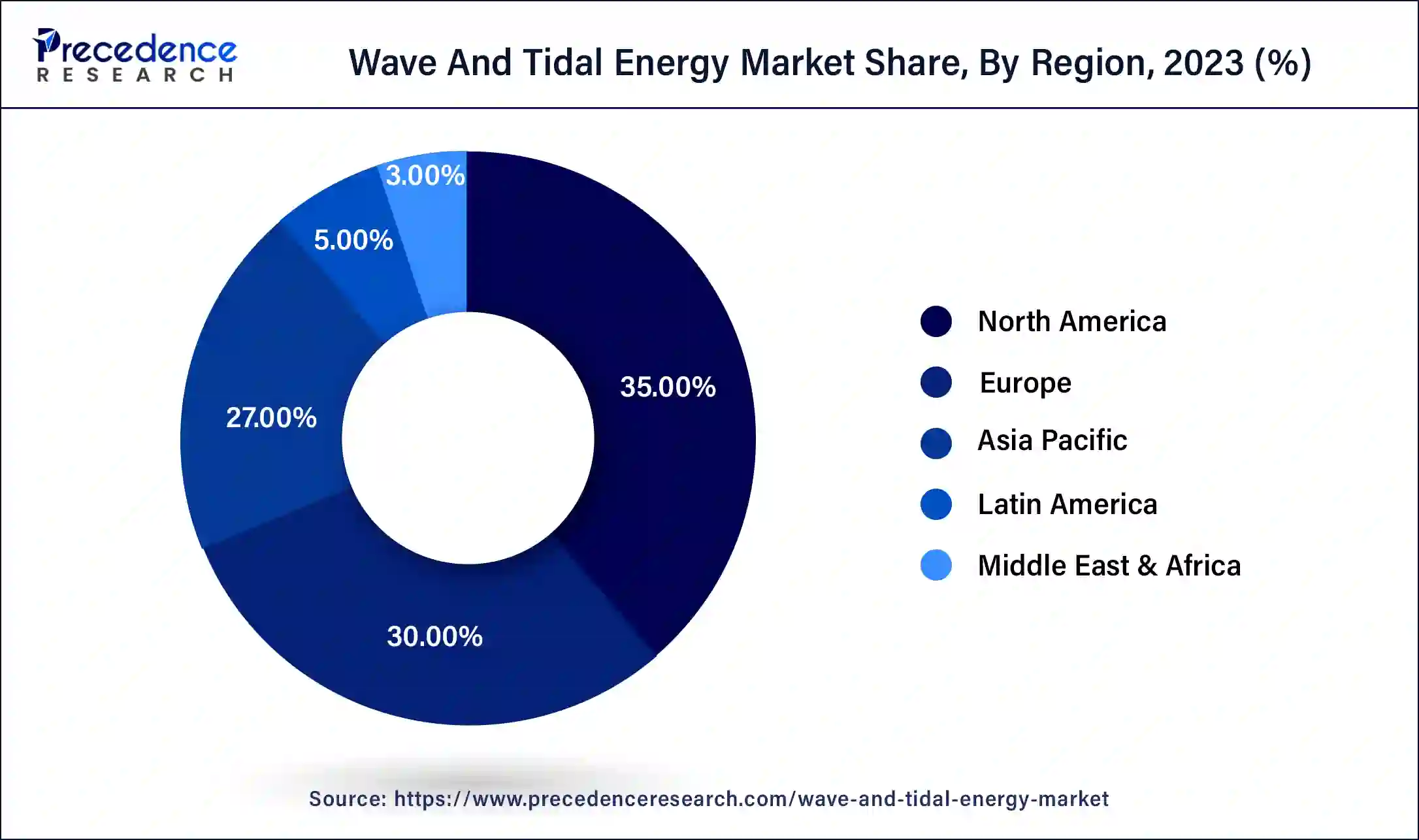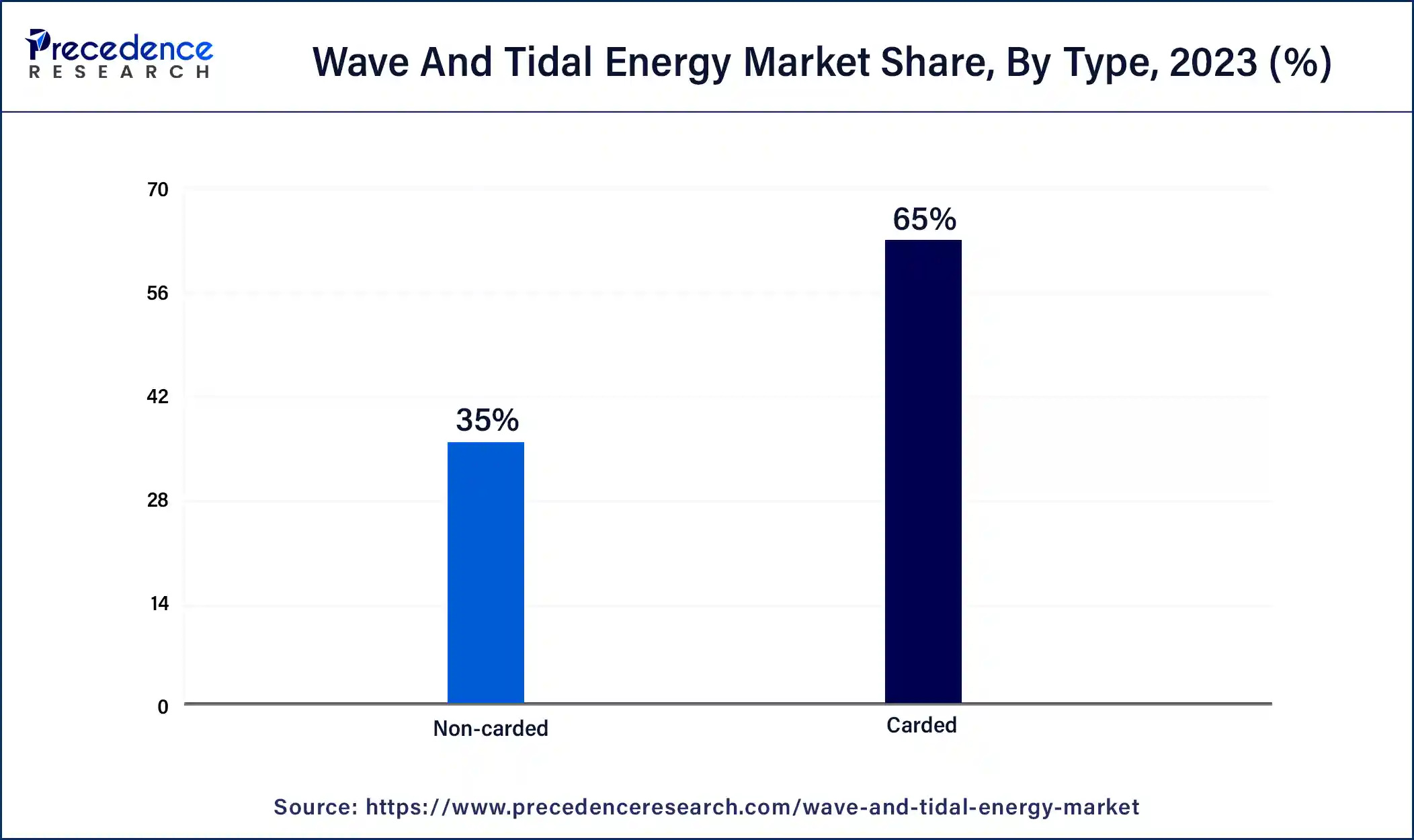April 2025
Wave And Tidal Energy Market (By Type: Wave Energy, Tidal Energy; By Technology: Tidal stream generator, Oscillating Water Columns, Tidal turbines, Tidal barrages, Tidal fences; By Application: Power generation, Desalination) - Global Industry Analysis, Size, Share, Growth, Trends, Regional Outlook, and Forecast 2023-2032
The global wave and tidal energy market size was USD 500.20 million in 2023, calculated at USD 544.22 million in 2024, and is expected to reach around USD 1416.58 billion by 2034, expanding at a CAGR of 9.10% from 2024 to 2034.

The wave and tidal energy sector encompasses the utilization of oceanic wave and tidal movements to generate renewable power. It entails the advancement and deployment of devices like wave energy converters and tidal turbines to capture the kinetic and gravitational energy of water motion. This market exhibits considerable potential as a sustainable and dependable energy source, offering merits such as consistent electricity production and minimal ecological footprint. Governments, energy firms, and scientists are deeply engaged in exploring this domain, aiming to unlock the vast, yet largely untapped, energy-generating capacity within oceans, promoting clean and sustainable power generation.
The U.S. wave and tidal energy market size was valued at USD 133.59 million in 2023 and is expected to reach USD 355 million by 2032, growing at a CAGR of 9.3% from 2024 to 2034.

North America has held the largest revenue share 35% in 2023. North America commands a significant share in the wave and tidal energy market due to its substantial investment in research, development, and deployment of these technologies. The region benefits from an abundance of suitable coastal locations and possesses a strong regulatory framework, which encourages industry growth. Additionally, government support in the form of grants, tax incentives, and initiatives further accelerates the market. North America's commitment to clean energy and its technological advancements have positioned it as a major player in the global wave and tidal energy market, attracting substantial investments and fostering innovation.

Europe is estimated to observe the fastest expansion. Europe commands substantial growth in the wave and tidal energy market due to several key factors. The region has demonstrated a strong governmental commitment to renewable energy, offering financial incentives and supportive policies that attract investments. Europe's extensive coastline provides ample potential for wave and tidal energy deployment. Additionally, the presence of leading technology developers and research institutions fosters innovation. Collaborative efforts and a mature offshore industry create a conducive environment for project development. These combined elements make Europe a significant player in advancing the wave and tidal energy sector, underlining its major growth in the market.
| Report Coverage | Details |
| Market Size by 2033 | USD 1416.58 Million |
| Market Size in 2023 | USD 544.22 Million |
| Market Size in 2024 | USD 592.65 Million |
| Growth Rate from 2024 to 2033 | CAGR of 9.10% |
| Largest Market | North America |
| Base Year | 2023 |
| Forecast Period | 2024 to 2034 |
| Segments Covered | Type, Technology, Application and Region |
| Regions Covered | North America, Europe, Asia-Pacific, Latin America, and Middle East & Africa |
Job creation and economic growth
The interplay of job generation and economic expansion constitutes a critical catalyst for propelling the wave and tidal energy market forward. This symbiotic relationship is instrumental in fostering the industry's growth. To begin, the inception and advancement of wave and tidal energy technologies precipitate the creation of employment opportunities spanning a wide array of sectors. This encompasses roles in research and development, engineering, manufacturing, installation, maintenance, and day-to-day operations.
The sector's demand for a skilled workforce, including technicians and engineers, drives the genesis of jobs, particularly in coastal locales where these ventures are typically situated. In doing so, it serves to mitigate unemployment rates and supports the sustenance of local communities.
Moreover, the wave and tidal energy domain triggers economic expansion by attracting investments. Governments, private investors, and international entities frequently allocate substantial resources to bolster research, development, and the commercialization of these technologies. This infusion of capital not only fuels innovation but also spurs economic activity, as it permeates research institutions, manufacturing facilities, and project infrastructure. Furthermore, wave and tidal energy undertakings necessitate regional supply chains and services, further amplifying economic prospects.
The cultivation of a novel industry ecosystem, which encompasses equipment production, maintenance services, and infrastructure development, has the potential to invigorate local economies. This invigoration, in turn, can furnish resilience against economic downturns and engender enduring economic stability in these coastal regions. To summarize, job creation and economic expansion serve as potent propellants for the wave and tidal energy market. They invigorate local economies, curtail joblessness, and entice investments, collectively bolstering the sector's sustainable progression and maturation.
Environmental impact and uncertainty
Environmental impact and uncertainty present notable constraints to the growth of the wave and tidal energy market. These challenges stem from the potential harm to marine ecosystems and habitat disruption associated with the installation and operation of wave and tidal energy devices. Such environmental concerns can result in stringent regulatory oversight, necessitating costly impact assessments, and mitigation measures, thereby increasing project complexity and costs. Moreover, the uncertainty surrounding the long-term ecological effects of these technologies can create reluctance among investors and communities.
The potential for unforeseen consequences on marine life and ecosystems poses risks that require careful monitoring and adaptive management. The industry's growth is contingent on addressing these environmental concerns through responsible and sustainable practices, such as strategic project placement, thorough impact assessments, and collaboration with environmental agencies. By mitigating these concerns and establishing best practices, the wave and tidal energy sector can navigate the regulatory landscape and garner greater acceptance, facilitating its expansion.
Renewable energy transition
The global transition toward renewable energy sources offers a significant opening for the wave and tidal energy market. As nations increasingly commit to curbing carbon emissions and embracing clean power, wave and tidal energy stand out as promising contributors to this worldwide transformation. These marine energy resources bring distinct advantages to the table. They deliver reliable and stable power generation, complementing intermittent renewables like solar and wind. This collaboration enhances grid stability, rendering wave and tidal energy indispensable in a diversified renewable energy mix.
Additionally, the expansion of the wave and tidal energy sector can aid in reducing reliance on fossil fuels and imported energy, bolstering energy autonomy. This aligns with the broader objective of attaining energy self-sufficiency and lessening vulnerability to geopolitical complexities and price fluctuations. In the pursuit of meeting renewable energy targets, both governments and industries have an opportunity to facilitate the growth of the wave and tidal energy market. This growth can stimulate employment, foster sustainable energy development, and help address the urgent issue of climate change.
Impact of COVID-19
According to the type, the wave energy segment has held a 65% revenue share in 2023. The wave energy segment holds a major share in the wave and tidal energy market due to its technological maturity and reliability. Wave energy systems are more advanced and have been commercially deployed, making them a preferred choice for investors and governments. They offer predictable and consistent power generation, making them easier to integrate into existing grids.

Additionally, the infrastructure required for wave energy projects is less complex compared to tidal energy. While tidal energy has significant potential, it is still in the earlier stages of development, and the wave energy segment has a head start in capturing a larger market share.
The tide energy segment is anticipated to expand at a significant CAGR of 10.8% during the projected period. The tidal energy segment holds a substantial share in the wave and tidal energy market due to several key factors. Tidal energy benefits from more predictable and consistent energy generation compared to wave energy, making it a reliable and attractive source of renewable power. Tidal currents follow regular patterns, offering grid stability.
Additionally, the technology for tidal energy is more mature and commercially viable, with projects in operation around the world. Its consistent performance and existing infrastructure give it a significant edge, making tidal energy a major player in the wave and tidal energy market.
The tidal stream generator segment held the largest market share of 50% in 2023. The tidal stream generator segment holds a significant share in the wave and tidal energy market due to its reliability and consistent power generation. Tidal currents are highly predictable, and tidal stream generators can operate at high-capacity factors, making them a dependable source of renewable energy. Additionally, the technology is more mature and commercially viable compared to some other wave energy conversion systems.
Governments and investors favor the proven track record of tidal stream generators, and their predictable output aligns well with grid requirements. As a result, they have captured a major share in the market, demonstrating steady and promising growth prospects.
The tidal fences segment is projected to grow at the fastest rate over the projected period. The tidal fences segment holds significant growth in the wave and tidal energy market due to its effectiveness in harnessing tidal energy. Tidal fences, or underwater turbines, are strategically placed in narrow channels or estuaries where tidal currents are strong, ensuring a consistent energy source.
Their predictable power generation, minimal environmental impact, and ability to be integrated into existing infrastructure make them a preferred choice. Additionally, their maturity and successful track record in pilot projects have instilled confidence in investors and governments, driving further development and deployment, thus maintaining a substantial growth in the market.
The power generation segment had the highest market share of 71% in 2023 based on the application. The power generation segment dominates the wave and tidal energy market due to its primary role in harnessing the potential of oceanic energy resources. Wave and tidal technologies are primarily developed for electricity generation, offering a clean and renewable energy source. Their consistent power production aligns with the need for reliable, grid-compatible energy. This segment is also supported by government incentives and investment, driving innovation and project development. As the global demand for sustainable energy grows, the power generation segment remains the focal point, making wave and tidal energy an attractive solution in the transition towards cleaner energy sources.
The desalination segment is anticipated to expand at the fastest rate over the projected period. The prevalence growth of the desalination segment in the wave and tidal energy market can be attributed to its multifaceted utility. Wave and tidal energy systems can effectively drive desalination facilities, serving a dual role by simultaneously generating clean energy and freshwater. This integrated approach provides a sustainable response to the critical issues of water scarcity prevalent in numerous coastal areas. Consequently, it garners attention from governmental bodies and investors alike. The synergistic relationship between energy production and desalination delivers cost-efficient and ecologically sound solutions, underscoring the significance of this sector within the broader wave and tidal energy market.
Segments Covered in the Report
By Type
By Technology
By Application
By Geography
For inquiries regarding discounts, bulk purchases, or customization requests, please contact us at sales@precedenceresearch.com
No cookie-cutter, only authentic analysis – take the 1st step to become a Precedence Research client
April 2025
January 2025
January 2025
January 2025